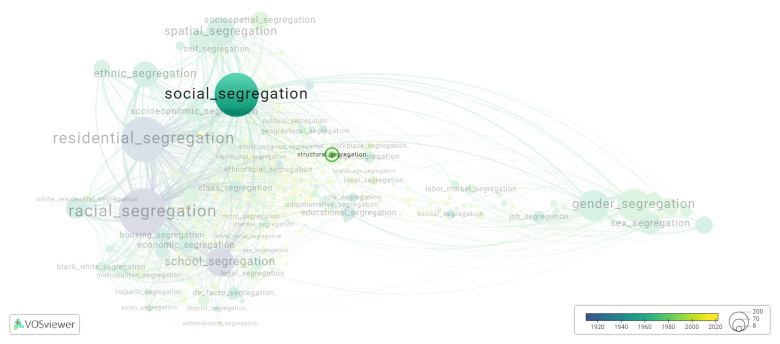Structural segregation
Date and country of first publication[1]
1990
United States
Definition
Structural segregation refers to the physical separation of different groups of people based on factors such as race, ethnicity, socioeconomic status, or religion. This separation is often enforced through laws, policies, and practices that restrict access to certain neighborhoods, schools, jobs, or other resources based on a person's identity. Structural segregation can perpetuate inequality and perpetuate discrimination, as it limits opportunities for certain individuals and perpetuates social divisions.
See also
Related segregation forms
Structural segregation is frequently discussed in the literature with the following segregation forms:
social segregation, racial segregation, urban segregation, role segregation, local segregation

This visualization is based on the study The Multidisciplinary Landscape of Segregation Research.
For the complete network of interrelated segregation forms, please refer to:
References
Notes
- ↑ Date and country of first publication as informed by the Scopus database (December 2023).
At its current state, this definition has been generated by a Large Language Model (LLM) so far without review by an independent researcher or a member of the curating team of segregation experts that keep the Segregation Wiki online. While we strive for accuracy, we cannot guarantee its reliability, completeness and timeliness. Please use this content with caution and verify information as needed. Also, feel free to improve on the definition as you see fit, including the use of references and other informational resources. We value your input in enhancing the quality and accuracy of the definitions of segregation forms collectively offered in the Segregation Wiki ©.
Structural segregation appears in the following literature
Eden J.A. (199). Race and the reproduction of factory labor in Malaysia. Environment & Planning D: Society & Space, 8(2), 175-190. https://doi.org/10.1068/d080175
Guo Z. (2001). To each according to its Niche: Analyzing the political and economic origins for a structural segregation in Chinese press. Journal of Media Economics, 14(1), 15-30. Lawrence Erlbaum Associates Inc..https://doi.org/10.1207/S15327736ME1401_02
Horn A. (2005). Measuring multi ethnic spatial segregation in South African cities. South African Geographical Journal, 87(1), 58-72. https://doi.org/10.1080/03736245.2005.9713827
Mesch G.S., Mano R. (2006). Housing attainment of immigrants from the former soviet union in Israel: A cost/benefit approach. Housing Studies, 21(3), 423-440. https://doi.org/10.1080/02673030600586068
Horsford S.R., Parra-Cardona J.R., Post L.A., Schiamberg L. (2011). Elder abuse and neglect in african american families: Informing practice based on ecological and cultural frameworks. Journal of Elder Abuse and Neglect, 23(1), 75-88. https://doi.org/10.1080/08946566.2011.534709
Catarci M. (2014). Intercultural education in the European context: key remarks from a comparative study. Intercultural Education, 25(2), 95-104. Routledge.https://doi.org/10.1080/14675986.2014.886820
Eller A., Abrams D., Koschate M. (2017). Can stateways change folkways? Longitudinal tests of the interactive effects of intergroup contact and categorization on prejudice. Journal of Experimental Social Psychology, 72(), 21-31. Academic Press Inc..https://doi.org/10.1016/j.jesp.2017.04.005
Ekholm D. (2017). Sport based risk management: shaping motivated, responsible and self governing citizen subjects. European Journal for Sport and Society, 14(1), 60-78. Routledge.https://doi.org/10.1080/16138171.2017.1284396
Butt A. (2018). City limits: Boundary conditions and the building cities of science fiction. Open Library of Humanities, 4(2), 1-31. Open Library of Humanities.https://doi.org/10.16995/olh.233
Downes P., Anderson J., Nairz-Wirth E. (2018). Conclusion: Developing conceptual understandings of transitions and policy implications. European Journal of Education, 53(4), 541-556. Blackwell Publishing Ltd.https://doi.org/10.1111/ejed.12305
Hughes J. (2018). Agency versus structure in reconciliation. Ethnic and Racial Studies, 41(4), 624-642. Routledge.https://doi.org/10.1080/01419870.2018.1381340
Romm J., Conrad E., Måren I.E. (2018). Resilient governance of water regimes in variable climates: Lessons from california's hydro ecological zones. Water (Switzerland), 10(2), -. MDPI AG.https://doi.org/10.3390/w10020196
de Kadt D., Sands M.L. (2021). Racial Isolation Drives Racial Voting: Evidence from the New South Africa. Political Behavior, 43(1), 87-117. Springer.https://doi.org/10.1007/s11109-019-09547-8
Kolak M. (2021). Distilling the Effect of the Great Recession on Food Access in a Segregated City: A Spatial, Quasi Experimental Approach. Professional Geographer, 73(4), 582-593. Routledge.https://doi.org/10.1080/00330124.2021.1922296
Sokolić I. (2022). Kiss, don’t tell: attitudes towards inter ethnic dating and contact with the Other in Bosnia Herzegovina. Identities, -. Routledge.https://doi.org/10.1080/1070289X.2022.2127666
Thomas J., Cruickshank V., Patterson K. (2022). Segregation and success in Tasmanian primary school sport carnivals. Sport, Education and Society, -. Routledge.https://doi.org/10.1080/13573322.2022.2076666
